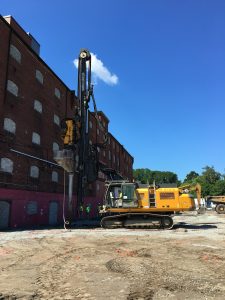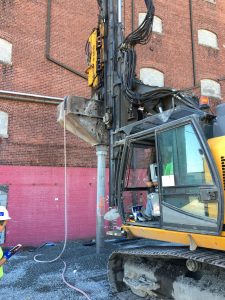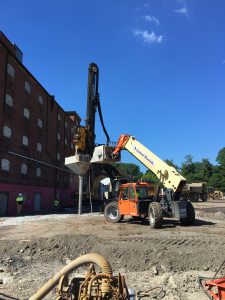Geopier® Rammed Aggregate Pier Elements Installed Within 5 Feet of Existing Structure
Introduction:
An existing warehouse required a 50,000 square-foot addition and needed to remain in-service during construction. The addition included column loads exceeding 300 kips and wall footing loads that surpassed 10 kips per linear foot.
Geotechnical Challenges:
The primary geotechnical challenges included the presence of fill up to about 7-feet-thick, soft organic soils up to about 3-feet-thick, and a shallow groundwater table. The unsuitable fill and soft organic soils were underlain by relatively dense glacial soils. Constructing conventional footings and slabs-on-grade directly on the existing unimproved fill and organic soils would have led to unacceptable settlement.
Geotechnical Design Solution:
The design team evaluated different foundation support solutions including: 1) shallow footings and slabs-on-grade after excavation and replacement of the unsuitable soils, and 2) shallow footings and slabs-on-grade after Geopier Rammed Aggregate Pier (RAP) ground improvement. Geopier RAP ground improvement was chosen as the most cost effective solution as it eliminated premium costs associated with the excavate/replace option, including off-site soil disposal, dewatering, potential shoring, and potential underpinning of the existing structure.
Geopier Rammed Aggregate Pier ground improvement allowed for conventional shallow footing and slab-on-grade construction and helped expedite the construction schedule. The RAP elements were designed to limit the total and differential settlement to less than 1 inch and ½ inch respectively, and provided a maximum allowable footing bearing pressure of five (5) kips per square foot.
Geopier Ground Improvement Advantages:
- Substantial cost savings compared to the excavate/replace option
- Permitted conventional shallow footing and slab-on-grade construction
- Displacement technique eliminated dewatering and excess spoils
- Fast installation that allowed the existing warehouse to remain operational
Ground Improvement Construction:
Helical installed more than 750 grouted Rammed Aggregate Pier (“GAP”) elements in about two weeks while the existing warehouse remained operational. GAP elements were installed using a displacement technique that did not generate excess spoils, further reducing premium off-site soil disposal costs. The use of grouted elements helped provide enhanced stiffness and settlement control through the unsuitable fill and soft organic soil layers. Below slabs, the GAP element shafts were grouted through the soft organic layer and the remainder of the shaft was constructed with ungrouted aggregate. Below footings, the GAP element shafts were fully grouted to form a “rigid inclusion” ground improvement element. An engineered granular fill “footing pad” was installed between the footings and the tops of the GAP rigid inclusion elements to help transfer footing stresses down into the elements and surrounding matrix soil. The footing pads also helped to provide a stable working subgrade for footing construction.
Quality Assurance and Control:
Helical’s crew included a full-time Quality Control person to oversee all testing and installation procedures. An individual GAP modulus test was performed to 150% of the GAP element design stress. The testing results showed deflections of less than about ½-inch at the design stress level indicating excellent performance of the Geopier ground improvement system.




